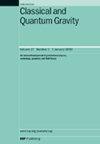突破极限:利用卫星星座探测新的重力
IF 3.7
3区 物理与天体物理
Q2 ASTRONOMY & ASTROPHYSICS
引用次数: 0
摘要
在早期工作的基础上,我们探索了使用卫星配置使用星间激光测距和定时观测设备来测量重力梯度张量轨迹的局限性,而不依赖于高精度的外部观测设备,如深空无线电导航或具有不切实际精度的天体测量。一个精练的模型,以扩展的数值精度计算,证实了特殊的灵敏度是可能的,它利用地球附近的日心轨道对某些修正的引力理论(例如汤川项、伽利略)进行观测试验。在较大的日心距离上,实验的灵敏度有所提高。一个位于30个天文单位的星座,使用现有的推进和深空通信技术,仍然在可行的范围内,可能会接近足够的灵敏度,不仅可以探测到行星际介质的引力贡献,甚至可能探测到宇宙暗物质和暗能量成分。本文章由计算机程序翻译,如有差异,请以英文原文为准。
Pushing limits: probing new gravity using a satellite constellation
Building upon earlier work, we explore the limits of using a configuration of satellites to measure the trace of the gravitational gradient tensor using intersatellite laser ranging and timing observables without relying on high-precision external observables such as deep space radio navigation or astrometry with unrealistic accuracy. A refined model, calculated with extended numerical precision, confirms that exceptional sensitivity is possible, placing within reach observational tests of certain modified gravity theories (e.g. Yukawa terms, Galileons) using heliocentric orbits in the vicinity of the Earth. The sensitivity of the experiment improves at larger heliocentric distances. A constellation placed at 30 astronomical units, still well within the domain of feasibility using available propulsion and deep space communication technologies, may approach sensitivities that are sufficient to detect not just the gravitational contribution of the interplanetary medium but perhaps even cosmological dark matter and dark energy constituents.
求助全文
通过发布文献求助,成功后即可免费获取论文全文。
去求助
来源期刊

Classical and Quantum Gravity
物理-天文与天体物理
CiteScore
7.00
自引率
8.60%
发文量
301
审稿时长
2-4 weeks
期刊介绍:
Classical and Quantum Gravity is an established journal for physicists, mathematicians and cosmologists in the fields of gravitation and the theory of spacetime. The journal is now the acknowledged world leader in classical relativity and all areas of quantum gravity.
 求助内容:
求助内容: 应助结果提醒方式:
应助结果提醒方式:


